Updated: And the winner is: NYFi!
Can something as simple as the payphone revolutionize communication and transform the functionality of New York City?
For the last few months, the City of New York has paid heavy attention to this idea, and has invited students, urban planners, designers, technologists and creators of all types to build physical and virtual prototypes of future payphones in the Reinvent Payphones Design Challenge. The designs were up for popular vote on Facebook up until today, May 15th:
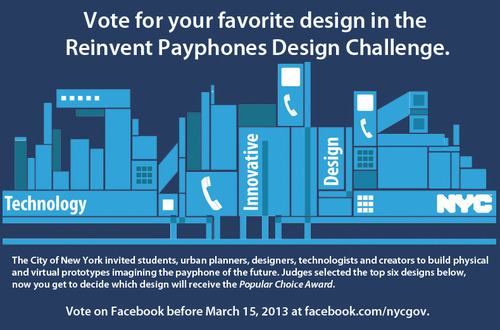
With the current payphone vendor agreements ending in 2014, the city probed think tanks and creators to develop new ideas on making the city healthier, greener, more accessible, safer, and better informed. The group with the best, most efficient, and feasible design entry will receive the “Popular Choice Award,” and therefore a greater chance of being realized as a new part of the New York City infrastructure.
NYC currently manages a network of 11,412 public payphones throughout the five boroughs. With the growing popularity and accessibility of smart phones, payphone use has decreased significantly. Still, every day thousands of New Yorkers place their coins in these somewhat obsolete payphones, especially in times of emergency.
The real challenge now for the participating design teams is how they can take the technology of smart phones and pair them with the infrastructure and accessibility of the payphone; in a way, the goal is transforming New York City into one enormous “genius phone.”
As of March 5th, a select panel of judges singled out six designs based on attentiveness to Connectivity, Creativity, Visual Design, Functionality, and Community Impact. From then until March 15th, the City of New York sought public opinion on the finalists via their Facebook page. New Yorkers could then vote on which finalist design they liked most. This “survey” will determine the winner of the Popular Choice Award, to be revealed today. Below are the six finalists with their respective details, information, and/or videos:
NYC I/O: The Responsive City
[youtube http://www.youtube.com/watch?v=Run-IbUzG8M?feature=player_detailpage&w=640&h=360]
Beacon
“Beacon is New York City¹s next generation open communications platform, connecting the city and its services with our communities, businesses, residents, and visitors. Beacon makes New York City more accessible, safer, healthier, greener, and better informed in our best of times and our most challenging.
Beacon was designed to connect New York City with New Yorkers, businesses and visitors. Beacon takes everything chaotic, colorful & loud about New York City and connects it back to us in an intelligent, purposeful & familiar way.”
Watch full video here
Windchimes
“Windchimes are environmental sensor stations that talk through payphones. They can plug directly into existing technologies and communication infrastructure, making them low cost and immediately deployable. We imagined New York City’s existing 11,000 payphones as a distributed sensor network providing real-time and hyper-local records of the city’s rain levels, pollution and other environmental conditions.
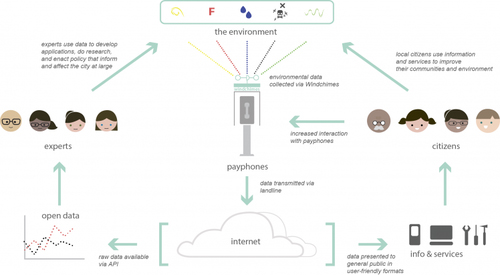 Windchimes’ design takes into consideration the growing availability of cheap, simple sensors and interest in big data. Each payphone’s sensor kit will be customizable so that it can serve the specific needs of the city and the communities within each neighborhood.”
Windchimes’ design takes into consideration the growing availability of cheap, simple sensors and interest in big data. Each payphone’s sensor kit will be customizable so that it can serve the specific needs of the city and the communities within each neighborhood.”
Watch Windchimes video here
NYC Loop
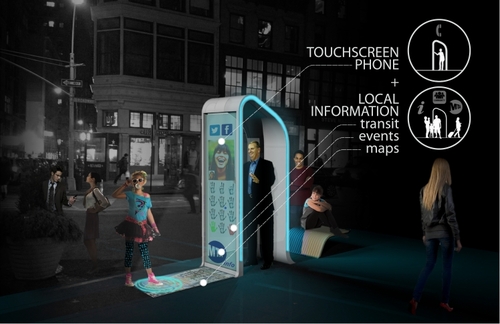 “NYC Loop combines a beautiful, contemporary payphone with a uniquely tailored public space that can be chosen to suit New York’s diverse communities. It provides sound harmonizing technology as well as a smart screen for making calls and enhancing personal mobile communication. Piezoelectric pressure plates convert kinetic energy into electric energy to supply the Loop with power.
“NYC Loop combines a beautiful, contemporary payphone with a uniquely tailored public space that can be chosen to suit New York’s diverse communities. It provides sound harmonizing technology as well as a smart screen for making calls and enhancing personal mobile communication. Piezoelectric pressure plates convert kinetic energy into electric energy to supply the Loop with power.
The Loop also features a responsive projector that creates an “information puddle” on the sidewalk with which any passerby can interact—an amazing opportunity for local artists or as a means of generating revenue from advertising space. The iconic design of NYC Loop and the relationship of its public space to the city’s neighborhoods will become an integral part of New York City’s urban identity.”
- Create an environment in which the latest technology is easily accessible to the general public
- Facilitate vibrant public space throughout the five boroughs
- Utilize untapped kinetic energy to develop a sustainable power source
NYFi
“The NYFi is an interactive portal to public information, goods, and services, a hub for free wireless internet access, and an open infrastructure for future applications.
The NYFi features two interfaces and a simple touch activates the height sensitive interactive zone on either face. Two models of the NYFi are proposed: a ten foot model for commercial and manufacturing districts and a smaller model for residential and historic districts where payphones have not traditionally been permitted. When not in use, the default display in commercial areas is interactive advertising and, in residential neighborhoods, way-finding and local interest posts. Its narrow profile minimizes sidewalk obstruction and improves safety and storefront visibility.
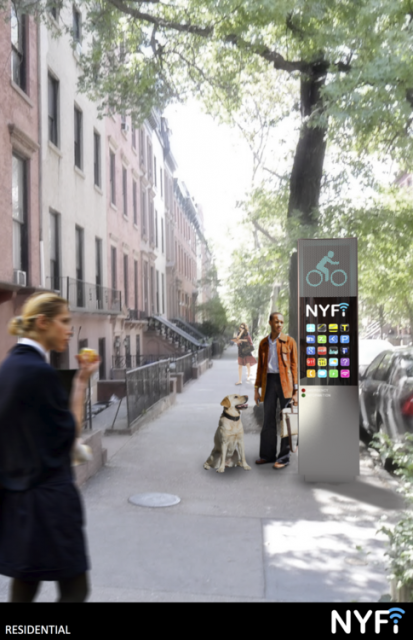 As an all-around communications hub, the NYFi has every expanding uses due to an open software platform that takes advantage of apps already created for smartphones and tablets. The combination of NYFi’s modular hardware and flexible software can replace the hodgepodge of single-function street appliances that currently litter the sidewalk such as bus ticket machines, Muni Meters, MetroCard machines, assistance kiosks, bicycle share stations and of course, payphones. In this way, these nodes can be modified and upgraded over time to adapt to the changing needs of the city and take advantage of new technologies that will emerge.”
As an all-around communications hub, the NYFi has every expanding uses due to an open software platform that takes advantage of apps already created for smartphones and tablets. The combination of NYFi’s modular hardware and flexible software can replace the hodgepodge of single-function street appliances that currently litter the sidewalk such as bus ticket machines, Muni Meters, MetroCard machines, assistance kiosks, bicycle share stations and of course, payphones. In this way, these nodes can be modified and upgraded over time to adapt to the changing needs of the city and take advantage of new technologies that will emerge.”
Smart Sidewalks
“Smart Sidewalks is driven by two competing aims: to pack as much function into a single device as possible and to reduce the phonebooth’s footprint. “Everything”–communication, sustainability, and wayfinding is squeezed into “nothing” – a 6” wide interactive strip that folds up from the sidewalk.
The design works within the existing 5’ sidewalk grid and has two main components. The first lies flush with the ground, and introduces a combined sensor and display with storm runoff storage below. The second stands vertical and functions as a touch-screen, Wi-Fi hub, energy source, charging station, and a range of other functions. In short, a location tethered smart-phone. The bent form is shaped by accessibility, viewing angle, and optimal solar exposure. A curb-cut bleeds storm water into storage cells dissipating it into existing soil. Sidewalk space is freed, putting to work the invisible space below.”
Watch Smart Sidewalks video here
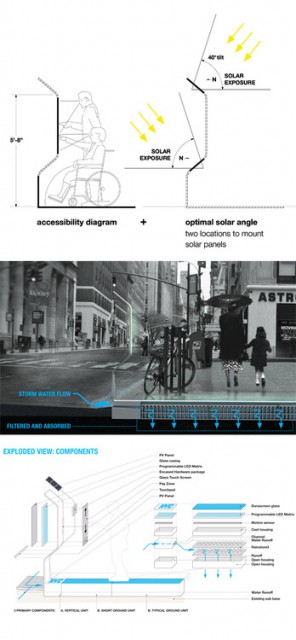 “The user interface is concentrated on the front panel and includes touch screen, camera, and sound inputs. The screen vertically scrolls accommodating a range of user heights. On the side are a credit card swipe, speaker, and charger. Built on the Android platform, existing apps are white listed by NYC and new ones are developed by third party vendors. NYC’s urban specific apps could be accessed by an increasingly diverse range of publics: think of it as a 21st century library without walls.
“The user interface is concentrated on the front panel and includes touch screen, camera, and sound inputs. The screen vertically scrolls accommodating a range of user heights. On the side are a credit card swipe, speaker, and charger. Built on the Android platform, existing apps are white listed by NYC and new ones are developed by third party vendors. NYC’s urban specific apps could be accessed by an increasingly diverse range of publics: think of it as a 21st century library without walls.
While Smart Sidewalks can function as a stand-alone device, it also networks, charges, and augments existing mobile devices. The 6” wide ground strip both conveys and gathers information. Like a vehicular road counter, Smart Sidewalks passively tallies every wheelchair, child, and jogger 24/7. This massive nodal network senses wind speed, rain fall, temperature, and foot traffic with unprecedented granularity. In emergencies,Smart Sidewalks guides citizens away from danger to higher ground. Thinfrastructure is self-sustaining and can go off-grid when infrastructure fails. As a publicly accessible database, information gathered from street-sides of NY will stand to fundamentally reshape the city. With a single curb cut and a thin strip of technology NYC prepares for a changing climate, gives maximum functionality to the technological savvy, and lowers the digital divide.”
… For more information on each new payphone design, visit NYC Digital, and check back here to see the winner of the contest.
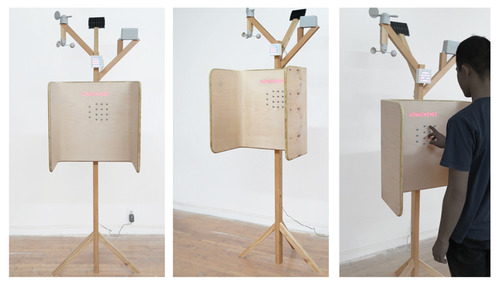
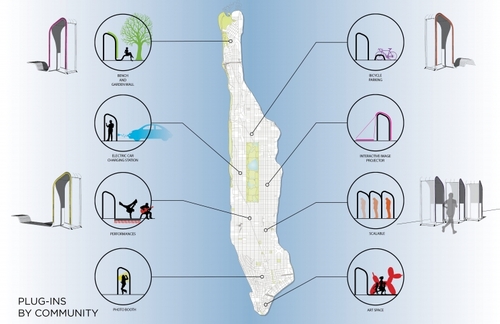
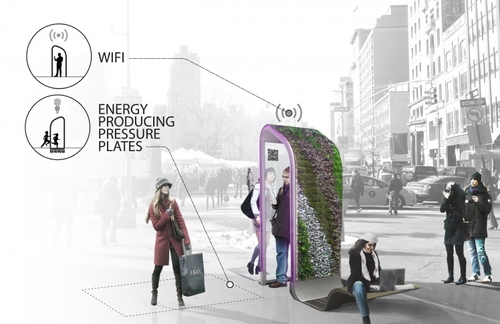
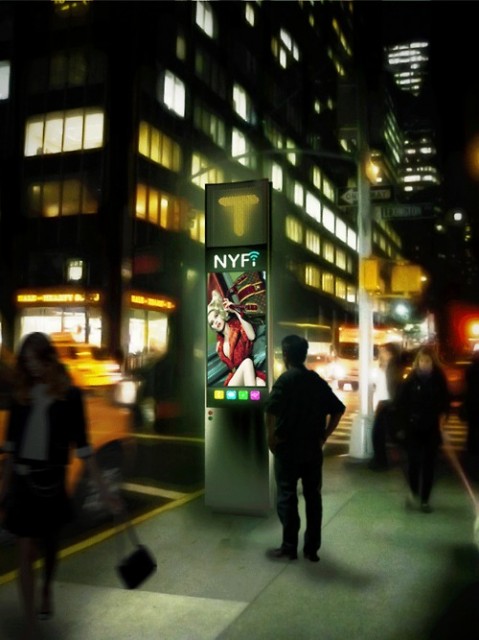

1 Comment
Comments are closed.